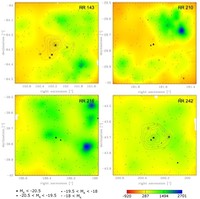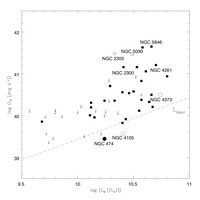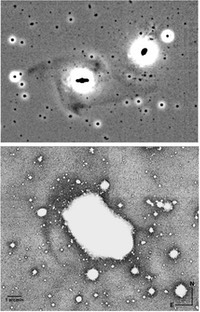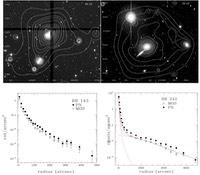Figure 1. Top panels: X-ray isointensity contours of RR 143 (NGC 2305/2307: left) and RR 242 (NGC5090/5091: right) observed with XMM-Newton superimposed to WFI R-band images. The emission is centred on the bright E member, but it is not smooth and symmetric in the case of RR 143. Bottom panels: Surface brightness profile of the X-ray emission.
X-ray detected Elliptical+Spiral galaxy pairs in LDE
We investigated several interacting pairs combining the investigation of the optical photometric and kinematic properties of the bright member galaxies with the search for a faint galaxy population associated to them as well as a study of their hot, warm and cold gas components (Rampazzo et al. 2005, MNRAS, 356, 117; Grutzbauch et al. 2005, AJ, 129, 1832; Grutzbauch et al. 2005, MNRAS, 364, 146; Grutzbauch et al. 2007, AJ, 133 220).
We show here a study of the environment of mixed morphology E+S galaxy pairs from the Reduzzi & Rampazzo (1995) catalogue. The pairs RR 143, RR 210, RR 216 and RR 242 were observed in the optical light with the MPG/ESO 2.2m telescope equipped with the WFI and in X-rays with XMM-Newton (RR 143 and RR 242; Figure 1) and ROSAT (RR 210 and RR 216: Trinchieri & Rampazzo 2001). The ROSAT observations suggested that the X-ray luminosity of RR 210 and RR 216 is about two orders of magnitude lower than those of RR 143 and RR 242 although the optical and kinematic properties of the pair and of the ETGs are very similar. The effects of the on-going interaction in RR 210 and RR 216 are shown in Figure 2.
On the ground of color photometric relations we isolate a set of faint candidate galaxies possibly associated to the above systems. The spatial distribution of the of the detected candidates is shown in Figure 3.
Our study shows that both X-ray luminous E+S pairs RR 143 and RR 242 are likely the dominant members of evolved groups. Only a few luminous members are associated with these systems, although we need to verify the population of faint members.
RR 210 and RR 216 are likely the dominant members of evolving groups. Arp 227 is a prototypical example of this class of objects (Rampazzo et al. 2006).
At odds with their optical, kinematic (mass), and environmental similarities, the ETGs in our E+S pairs have remarkably different X-ray properties (Figure 4). We suggest that this can be explained in terms of either the present evolutionary phase of the system or the past histories of the ETGs.
Spectroscopic observations at ESO Very Large Telescope + Visible Multiobject Spectrograph providing redhsifts for the faint galaxy populations have been obtained for RR 143, RR 242 and partly for RR 210 and RR 216. These results allow us to better understand the evolutionary stage of the above systems [see page 2].
more details in
Grutzbauch R., Trinchieri, G., Rampazzo R., Held E.V., Rizzi L., Sulentic J.W., Zeilinger W.W.
Small-scale system of galaxies. III. X-ray detected E+S pairs in low density environment
2007, AJ, 133, 220



